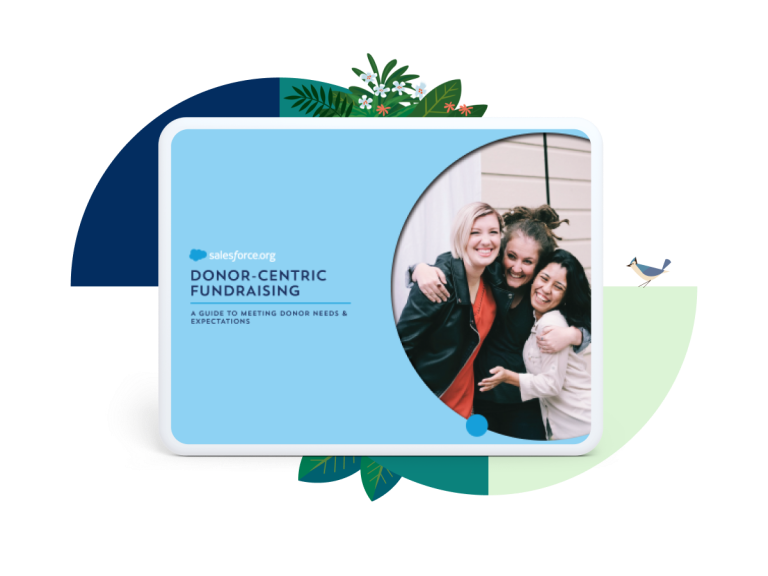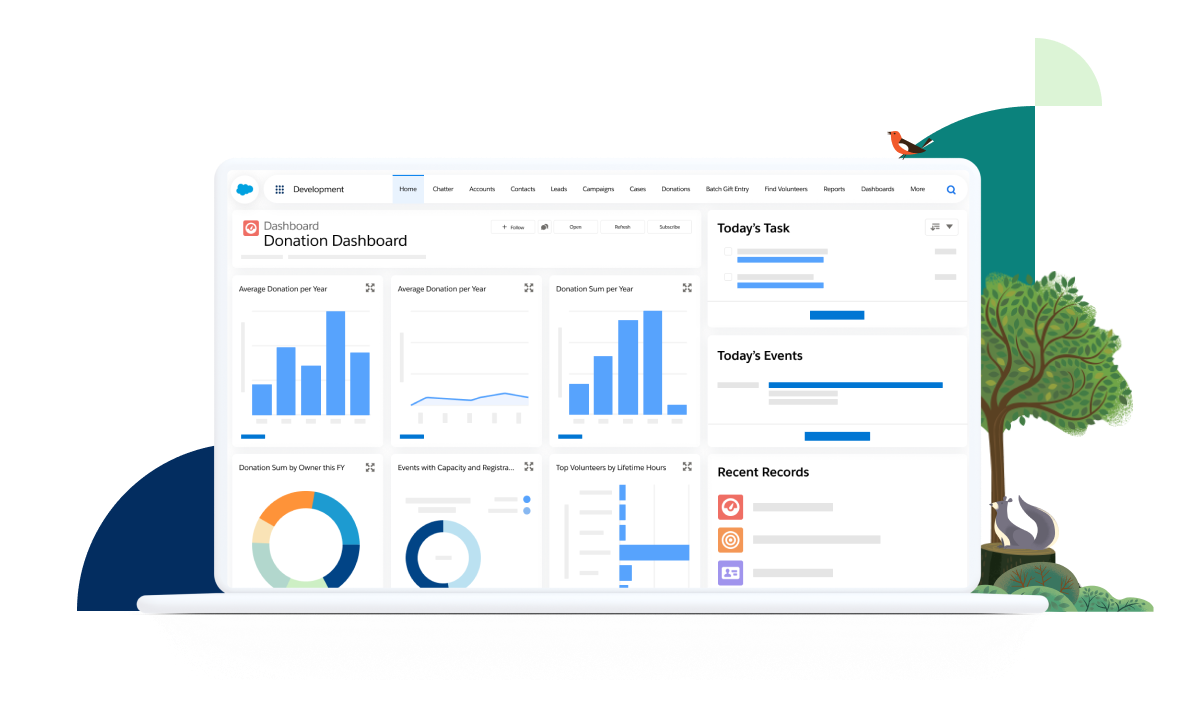Developing stronger donor relationships
Donor cultivation, much like a bonsai tree, requires patience, attention to detail, and a solid strategy for best results. When donors are your biggest assets, facilitating their journey from prospect to lifetime donor can be a long, but rewarding process known as the moves management process. Every touch — and every engagement throughout this cycle — leads you one step closer to the essential funding you need to continue your meaningful work.
In this article, we will dig into the fundraising cycle, discuss moves management best practices, and lay out the important metrics to track for the most effective moves management strategy.
What is moves management?
A nonprofit moves management cycle is no different than the for-profit sales cycle or funnel. In both cases, constituents, whether they are donors or buyers, are carefully tracked — or moved — through a process from prospect to repeat donor or customer. Prospects are identified, donor relationships are built and nurtured, and with every engagement opportunity, the prospect is pushed a little closer toward converting to the next level of participation.
Understanding the donor life cycle
Timing is everything with moves management fundraising. Some stages of the lifecycle may take longer than others depending on the type of donor you are cultivating. Before diving into your moves management strategy, it’s important to understand the overall donor life cycle.
Acquisition phase
The acquisition phase is all about prospects — the people who haven’t donated yet but are ideal for supporting your organization. To figure out who these people might be, where to find them, and what motivates them, it’s a good idea to create prospect personas.
To do this, you will need to collect some basic demographic information about your target audience. How old are they? Where do they live? What types of jobs do they have, and what is their income range? What are their pain points, and what motivates them? With that information, you will create two to three fictional characters — or prospect personas — based on types of people you want to target.
With prospect personas in mind, it’s easier to create custom, curated engagement pipelines, since each persona may respond differently to various types of outreach and engagement. Some may prefer phone calls, in-person meetings, or opportunities to volunteer or attend events. Others may favor email newsletters or printed publications about your organization that they can study on their own time.
No matter their preference for message delivery, be sure your content includes compelling storytelling that shares why their involvement in your organization will change lives, including their own.
Retention phase
After you’ve determined your prospects, made the initial donation request, and received the first gift to your organization, your prospect officially becomes a donor. But the donor cycle is not complete. During the retention phase, the relationship between the nonprofit and the donor continues to grow.
Upgrade phase
Over time, you’ll want to steward one-time donors into becoming repeat donors who give annually or major donors who give large sums. Increased giving, however, requires a strong moves management strategy built around understanding the motivation behind your donors’ gifts. You’ll need a smooth transition from one stage of the donor life cycle to the next.

Guide
Nonprofit Fundraising Guide
Learn the keys to sustainable fundraising in a constantly changing world.
The moves management fundraising process
There are many ways to move donors through the moves management system. Whether your approach is active or passive, having a strategic infrastructure for your moves management cycle can streamline your campaigns. Here’s a guide on where to start.
1. Foster awareness
The first step is to catch supporters’ eyes with compelling content or visuals around your mission. This step can occur during the acquisition phase of the donor life cycle to attract prospects, and it also can spread awareness of new initiatives to existing donors. Convince them why they should choose to support your organization over the millions of others. This is not an ask — it’s simply an educational phase. You can tell your story at donor events or through printed or digital materials.
Try to vary the content you create to spread awareness about your mission. Include a mix of blog posts, videos, infographics, and testimonial-driven content. In addition to varying the content, you’ll also want to use multiple distribution channels including email and social media.
To be sure you’re getting the right content in front of the right audience, just ask. Ask your donors how they prefer to receive information or be communicated with via a survey, email, phone call, or in person. Ask them what their interests are as they relate to your organization. If you use a customer relationship management (CRM) system, you can set up fields to collect, sort, and analyze this information before sending out digital or print communications. This allows you to both personalize and respect their requests.
2. Get to know your donors
Forming solid relationships with your supporters is key to donor retention. To build donor relationships and bring in new gifts, you first need to know who in your larger network is in a position to give and at what level. Audit your current donor list, refer to those prospect personas, and figure out whom to prioritize. Who will you ask to become a recurring donor? Who will you ask to increase their current giving? Use wealth screening sites to make prospect wish lists. Researching your donors ahead of time will help you with segmenting communications and outreach. It also will save you time in the long run because you won’t be targeting donors who lack the resources to give.
3. Create touchpoints
During the third stage of the moves management cycle, it’s time to work with your team to create a cultivation calendar. Determine when you will reach out to donors, and how. Optimal outreach dates will depend on your organization, but birthdays and anniversaries are obvious choices. This is also an opportunity to show individual donors that you really know who they are. If a donor loves Formula One racing, you can time your touchpoint near race day to talk to her about the event. If a donor has a beloved dog, reach out to him on National Dog Day or send his dog a new toy or some gourmet biscuits.
These touchpoints aren’t about asking for gifts, just touching base to stay top of mind and to let donors know you’re thinking of them. If you don’t want to tie your outreach to a specific event, you can do this simply through one-on-one interactions like getting a coffee or emailing them an article you think they might like. Or you could ask them to volunteer at an upcoming event for your organization. Whatever you do, be sure it’s personal to strengthen donor retention.
4. Make the ask
When you’re finally ready to ask your donor for financial support, there are some key points to remember. First, be specific about what you want. Do you want them to sponsor an event? Set up a recurring payment? Include your organization in a bequest? Being specific with your ask will reduce the work your donor has to do and increase your level of success during the retention and upgrade phases of the fundraising cycle. You should also be ready with multiple payment options that are convenient to make this a pleasant experience they are likely to repeat.
In addition, be strategic about when you make the ask. Timing it around a special event, organization anniversary, or the end of the calendar year when people are trying to submit charitable contributions for tax deductions, are all good options.
5. Say thank you
There are so many creative ways to show donors that you are grateful for their participation. Always send handwritten thank you notes to major donors — bonus points for swag bags, which double as advertising for your organization. When you send them gifts branded with your organization’s name, every time they use them they’ll be spreading awareness for your mission.
For recurring donors, you could send a personalized email to explain the impact of their gift. Recapture the interest of one-time donors with thank you content that drives further interest during the upgrade phase of the donor cycle. And continue to acknowledge donors throughout the year to keep them engaged.
Whatever moves management path you choose, be sure once the cycle is complete that you reevaluate often. Consider what worked and what didn’t, and make adjustments accordingly.

Guide
Donor-Centric Fundraising Guide
Explore how nonprofits can meet and exceed donor expectations.
Moves Management KPIs
Tracking metrics is crucial to reaching your moves management goals. Analytics and reporting will help you identify which areas are working well and which need extra attention to improve. Here are some tips for tracking metrics to help you create the perfect moves management strategy.
1. Go digital
When seeking donations in the digital age, it’s crucial to meet donors where they are — online. Be sure your online donation platform delivers a top tier user experience on all devices, including mobile. Only ask donors to provide information you truly need to keep the form simple and respect their time. Add instructions that clearly guide them through the process, while also reminding them of the impact of their gift.
2. Track your interactions
A nonprofit CRM will help you track all donor interactions, moves, and preferences, all in one place. It’s easy to build donor relationships when you have access to past conversations, gifts details, and engagement. This information can help you make clear and straightforward decisions about what questions to ask and when to ensure donors feel valued throughout the moves management process.
If you don’t have a nonprofit CRM, you can also track donor interactions in an excel or Google spreadsheet, although these tools lack the automation, donor insights, and other powerful features that make a CRM worth the investment.

3. Seek quantitative and qualitative data
When tracking moves management, both quantitative and qualitative data have value. For quantitative data, consider tracking these metrics:
- # of prospects identified
- # of touches/contacts
- # of discovery calls/visits conducted
- # of cultivation calls/visits conducted
- # of asks/solicitations
- # of gifts closed
- # of stewardship calls/visits
- total dollars raised
For qualitative data, you’ll want to dig into more donor-centric information, such as:
- The donor’s consideration stage
- Whether or not they are qualified based on their passion toward your organization
- How they rank your organization compared to others
- How important they feel your organization’s mission is
- The quality of each engagement according to the donor’s feedback after engaging with a fundraiser
This type of qualitative data can be measured through surveys, which can help you develop your moves management strategy. Ask donors why they donated, how their donation experience was, and how they view your organization. You can also invite them to provide a testimonial about your organization, which can then be used in print and digital materials to encourage prospects to become donors or influence existing donors to upgrade future gifts.
Donor retention is another important metric to track. This number will tell you how many of your donors are sticking around year after year. You obviously want to aim for a higher donor retention rate, but it’s good to know your rate even if it’s low — this will let you begin determining areas for improvement and create a donor retention plan. Remember to regularly check in on your donors and factor their feelings and opinions about your organization into your retention plan.

“The biggest thing we’ve done since WWF started all those decades ago, is move from a campaign-driven organisation to a data-driven one.” Paul Zevenboom, Head of Digital, eCommerce and Consumer DataWWF Netherlands
Developing strong, lasting donor relationships takes time. Databases must be pruned. Decisions must be precise. Moves management strategies must be implemented and regularly evaluated. Like a well-cared-for bonsai tree, every detail matters.
